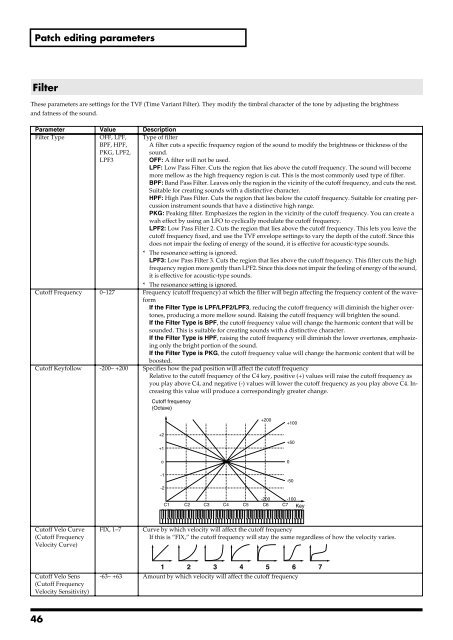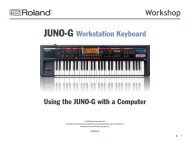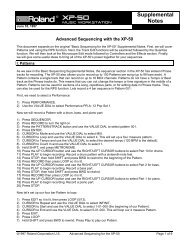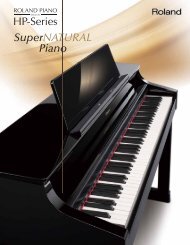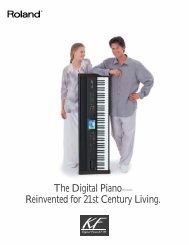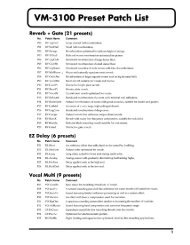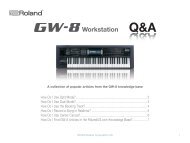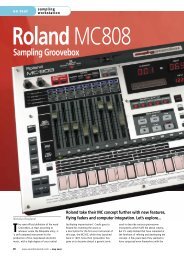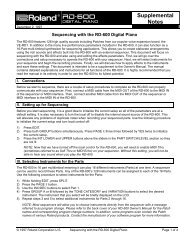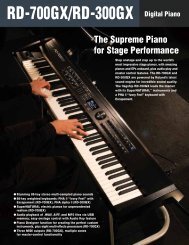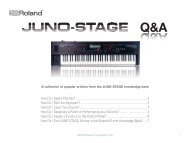You also want an ePaper? Increase the reach of your titles
YUMPU automatically turns print PDFs into web optimized ePapers that Google loves.
Patch editing parametersFilterThese parameters are settings for the TVF (Time Variant Filter). They modify the timbral character of the tone by adjusting the brightnessand fatness of the sound.<strong>Parameter</strong> Value DescriptionFilter TypeOFF, LPF,BPF, HPF,PKG, LPF2,LPF3Type of filterA filter cuts a specific frequency region of the sound to modify the brightness or thickness of thesound.OFF: A filter will not be used.LPF: Low Pass Filter. Cuts the region that lies above the cutoff frequency. The sound will becomemore mellow as the high frequency region is cut. This is the most commonly used type of filter.BPF: Band Pass Filter. Leaves only the region in the vicinity of the cutoff frequency, and cuts the rest.Suitable for creating sounds with a distinctive character.HPF: High Pass Filter. Cuts the region that lies below the cutoff frequency. Suitable for creating percussioninstrument sounds that have a distinctive high range.PKG: Peaking filter. Emphasizes the region in the vicinity of the cutoff frequency. You can create awah effect by using an LFO to cyclically modulate the cutoff frequency.LPF2: Low Pass Filter 2. Cuts the region that lies above the cutoff frequency. This lets you leave thecutoff frequency fixed, and use the TVF envelope settings to vary the depth of the cutoff. Since thisdoes not impair the feeling of energy of the sound, it is effective for acoustic-type sounds.* The resonance setting is ignored.LPF3: Low Pass Filter 3. Cuts the region that lies above the cutoff frequency. This filter cuts the highfrequency region more gently than LPF2. Since this does not impair the feeling of energy of the sound,it is effective for acoustic-type sounds.* The resonance setting is ignored.Cutoff Frequency 0–127 Frequency (cutoff frequency) at which the filter will begin affecting the frequency content of the waveformIf the Filter Type is LPF/LPF2/LPF3, reducing the cutoff frequency will diminish the higher overtones,producing a more mellow sound. Raising the cutoff frequency will brighten the sound.If the Filter Type is BPF, the cutoff frequency value will change the harmonic content that will besounded. This is suitable for creating sounds with a distinctive character.If the Filter Type is HPF, raising the cutoff frequency will diminish the lower overtones, emphasizingonly the bright portion of the sound.If the Filter Type is PKG, the cutoff frequency value will change the harmonic content that will beboosted.Cutoff Keyfollow -200– +200 Specifies how the pad position will affect the cutoff frequencyRelative to the cutoff frequency of the C4 key, positive (+) values will raise the cutoff frequency asyou play above C4, and negative (-) values will lower the cutoff frequency as you play above C4. Increasingthis value will produce a correspondingly greater change.Cutoff frequency(Octave)+200+100+2+1o+500-1-2-50-200 -100C1 C2 C3 C4 C5 C6 C7 KeyCutoff Velo Curve(Cutoff FrequencyVelocity Curve)FIX, 1–7Curve by which velocity will affect the cutoff frequencyIf this is “FIX,” the cutoff frequency will stay the same regardless of how the velocity varies.Cutoff Velo Sens(Cutoff FrequencyVelocity Sensitivity)1 2 3 4 5 6 7-63– +63 Amount by which velocity will affect the cutoff frequency46


